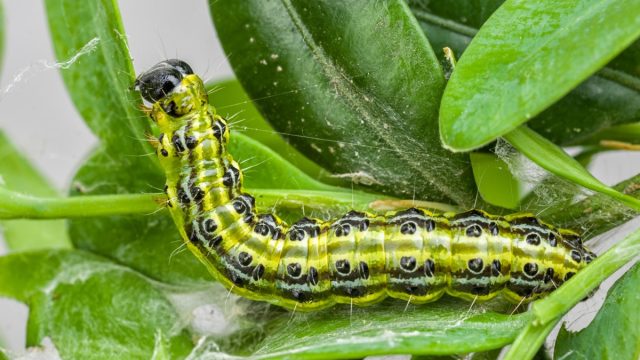If You See This Invasive Insect, Call Officials Immediately

Moths—often thought of as less appealing butterflies—are generally thought to be a mild nuisance. However, if you’ve ever had a moth do damage to your favorite sweater or make its way into your pantry, you know they’re not as innocent as they look. And moths start out as caterpillars, which can wreak havoc of their own. Just read The Very Hungry Caterpillar if you don’t believe us. Now, experts are warning people in the U.S. about the invasive box tree moth, which decimates certain plants in caterpillar form. Officials ask that if you see this insect, you report it immediately.
RELATED: If You See This Bug, Crush It Immediately, USDA Says.
On May 28, the U.S. Department of Agriculture (USDA) confirmed that what they feared was true—box tree moths have made their way to the continental U.S. The agency and its state partners have begun taking action “to contain and eradicate the invasive pest,” which was imported on nursery plants in a shipment from Ontario, Canada.
According to the USDA, “The box tree moth can significantly damage and potentially kill boxwood plants if left unchecked.” The measures the USDA is taking to contain and eradicate the moth are aimed to protect “the economic viability of the thriving U.S. boxwood industry as well as nurseries and other establishments that sell these plants wholesale and direct to consumers.”
The USDA said people who own boxwood plants can help by allowing state or federal officials to inspect their plants. People can also inspect the plant themselves and report any signs of the moths or moths themselves to their local USDA office or state agriculture department. Signs of boxwood moths include caterpillars, webbing, and egg masses under the leaves.
RELATED: For more up-to-date information, sign up for our daily newsletter.
According to Nursery Management, adult box tree moths have white bodies and brown heads and abdomens. Most commonly, their wings are white and slightly iridescent, with a thick brown border. However, some adult box tree moths have completely brown wings with a small white streak on the forewings. The eggs of these moths are pale yellow and can be found in clusters on the underside of leaves. When in the pupae stage, the moths lay in a silk cocoon that begins green with black stripes but eventually turns brown. And per PennState Extension, the caterpillars, which feed on the plants, are “green and yellow with white, yellow, and black stripes and black spots.”
The USDA reports that seven states received shipments of boxwood plants that are thought to have been infested with box tree moths. Read on to see if you live in any of the following seven states, and look out for signs of the box tree moth to report to officials.
RELATED: If You See This Bug, Never Touch It Without Gloves & a Mask, Experts Warn.
1
Connecticut

2
Massachusetts

3
Michigan

4
New York

5
Ohio

6
South Carolina

7
Tennessee

RELATED: If You See This Bug in Your Home, Don’t Step on It, Experts Warn.